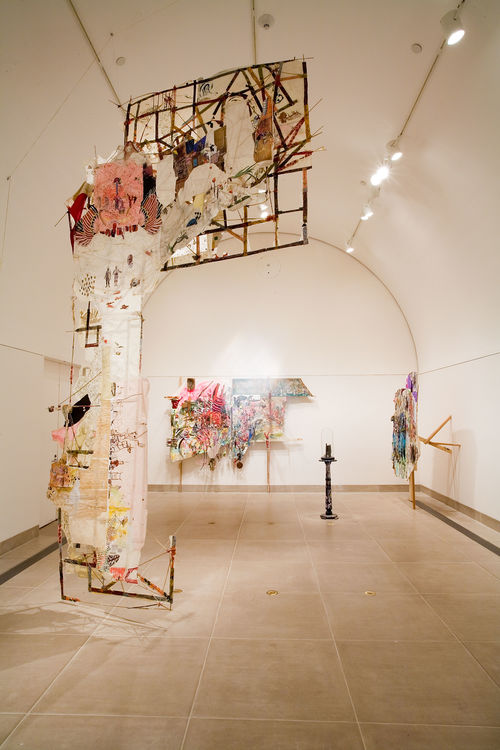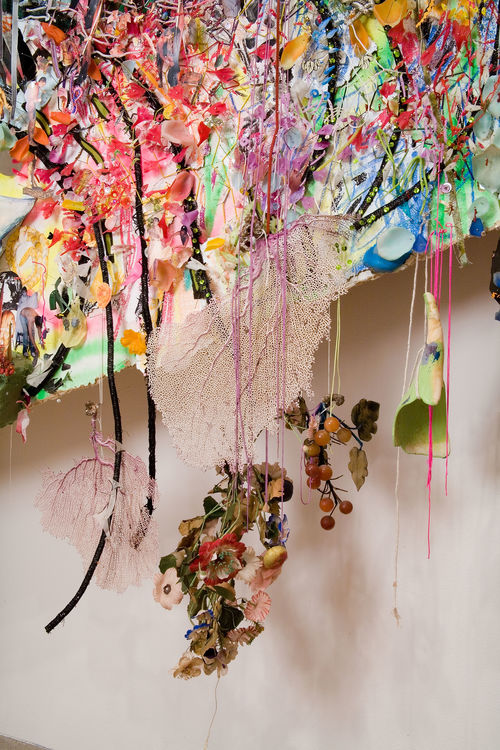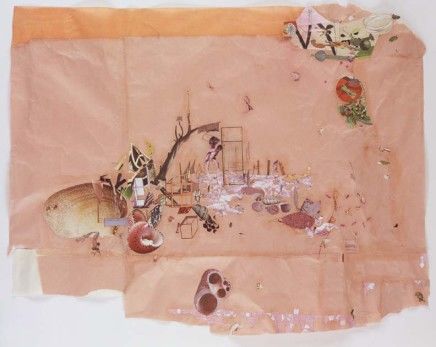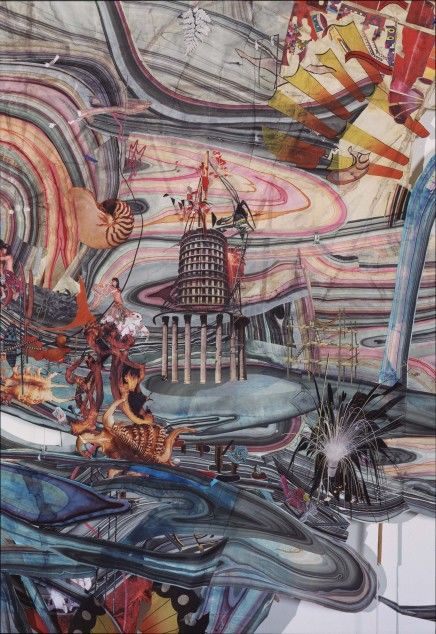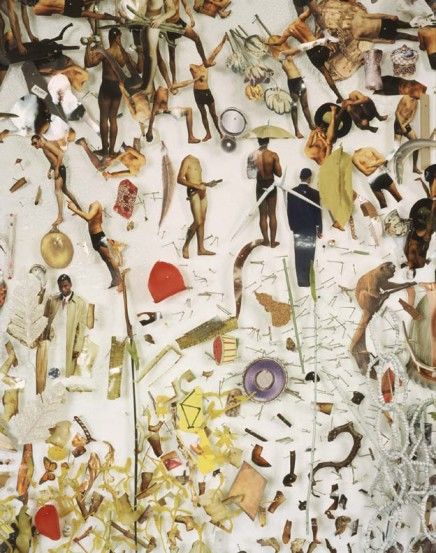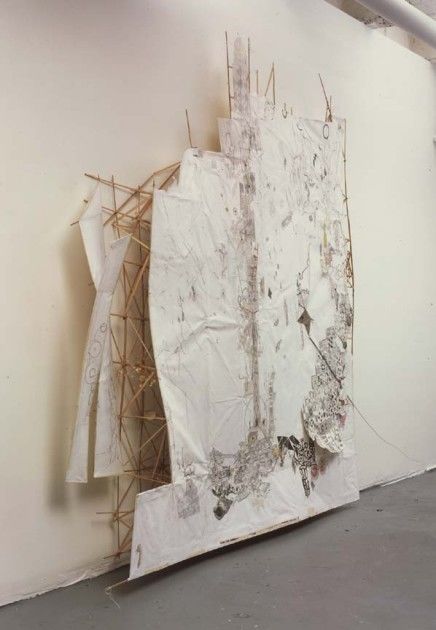
Hammer Projects: Elliott Hundley
- – This is a past exhibition
Elliott Hundley creates collages from thousands of cut-up magazines, personal photographs, drawings, and a variety of commonplace objects including feathers, strings, and twist ties. With titles that often refer to classical drama and mythology, each work represents a fantastical world full of cryptic imagery and meaning. In the Hammer Museum's Vault Gallery, Hundley will exhibit large-scale constructions made from delicate papers and ephemera affixed to wooden sculptural forms.

Biography
Elliott Hundley received his MFA in 2005 from UCLA and currently lives in Los Angeles. He graduated from the Rhode Island School of Design with a BFA in printmaking in 1997 and also attended the Skowhegan School of Painting and Sculpture in 2002. His drawings and collages have been shown in group exhibitions in New York at Daniel Reich Gallery and Andrea Rosen Gallery, and in Los Angeles at Cherry and Martin, Regen Projects, and Peres Projects. His work is found in several important collections, including those of the Museum of Modern Art, New York; the Solomon R. Guggenheim Museum, New York; and the Museum of Contemporary Art, Los Angeles. This is Hundley’s first solo museum exhibition.
Essay
By Catherine Taft
Elliott Hundley crafts delicate assemblages that coerce the viewer into an ongoing, even epic, visual narrative. With a practice comprising photography, painting, collage, drawing, and sculpture, held together by a performative studio process, he allows the natural world to collide with both classical antiquity and the relics of modernity. The tiny figures that dwell in Hundley’s pictorial topographies seem to act out dislocated scenes from some new mythology. In Kindling for the Great Fire (2005), a rice-paper and wood wall sculpture that resembles the masts and sails of a tall ship, arching strokes of watery paint create a color-striated landscape or seascape on which printed matter, found textiles, and cropped figurative photographs are pasted. A system of thin bamboo shafts holds the paper construction together; on the ends of its protruding beams, neatly tied strings dangle toward the floor as if wanting to be anchored to stable ground. In the work’s collaged central scene, the duplicated image of a nude man circles around two-dimensional flames, conch shells, nautili, maize, and butterfly wings, among other papery vestiges. Each of the four cloned men grasps a bird-shaped paper kite and strikes a stoic pose. Nearby, an unstable architecture is formed by decoupage scaffolding, a coliseum-like tower and seven Doric columns. On the left, a grand schooner navigates the painted surface as if approaching the men’s ceremonial bonfire. Hundley stages similar scenarios on the textured facades of both his freestanding and wall-mounted objects. Using titles that often reference the witchier yarns of ancient civilization, such as Medea’s Craft (2005) and Untitled (Lydian Work) (2005), the artist, like some Penelope at her loom, weaves and unweaves a historical, personal, and symbolic fabric.
Enlisting close friends, Hundley arranges photo shoots to develop figurative prints from which to garner the expressionistic bodies of his complex compositions. The nude or semiclothed, predominantly male sitters are sometimes decorated with string, jewelry, tunics, or body paint. They clutch animated props, like poles and umbrellas, and are directed to act out heroic histrionics or a contrived naturalism. Although their images are ultimately clipped out of the photographic mise-en-scène, erasing the traces of a recognizable time and location, Hundley will often position his models in front of the very sculptures that their bodies are intended to adorn. While in various stages of completion, the works that appear in the margins of Hundley’s ephemeral photographs operate as a kind of set dressing for the action of the model. These structures—many of which are also “propped” as they lean against the studio wall—are used in a deliberate performance of scale that only Hundley and his models can observe firsthand; during the photo shoot, the models’ bodies are staged in relation to miniature corporeal representations, and their images will in turn be added to the two-dimensional troupe. Central to the artist’s sense of scale, this juxtaposition places human giants at the threshold of their pictured collapse.
Hundley’s works assume a double life, one in the gallery as an art object and another in the studio as a backdrop for dramatic, performative events. In this cooperative move, one can begin to consider what “theatricality” may mean to Hundley’s practice. In Art and Objecthood (1967), a hoary but still seemingly pertinent text, critic Michael Fried argued against the notion of theatricality—to crudely sum up this idea, the problematic ways in which the constructed event of displaying a work can become as significant as the artwork itself—that he considered to be inherent to minimal (literalist) sculpture. Although Hundley’s concerns are a far cry from those of minimalist rhetoric (in fact, he seems to retain the formal concerns of artists such as Bruce Conner and Jess, who continued to produce messy and illustrative work despite Fried’s puritanical argument and the art that engendered it), it is helpful to consider the relationships that his forms activate with the spectator in space. In Untitled (Screen) (2005), the artist uses a freestanding, five-paneled screen or room divider as the support for his geometric patterning, multiplanar collage, and dense, atmospheric painting. Its two foam-padded faces are gesturally tacked with vinyl, ready-stitched craft patches, plastic bags, pastel silk flower petals, a harvest of sequins, warped oversize candles, and sparse photographic figurines. On one side of the object, Hundley has traced the outline of a table and still life lifted from an illusionistic paining that was given to him by an artist friend. The table and still life are patterned from solid black velvet, simplifying the likeness into a flat negative space. Pinned to the foam, this roughly life-size image is proportionate to the viewer who stands before it. In the act of observing, the viewer is cast into Hundley’s dramatization of space.
Hundley’s new work for the Hammer loosely adopts the splintered form of half a proscenium arch—the architectural device that separates a stage from the auditorium in a theater—using the gallery wall to move upward and overhead, as if beginning to define a frame. This work’s most remarkable features are not its Brechtian characteristics but rather the ways in which it continues Hundley’s ongoing drama-queen pursuits, a sensibility that has taken shape in earlier works. He continues the deliberately slapdash practice of affixing gathered things; paper umbrellas, coral, crystals, skin-toned wax, shark teeth, and Brazilian beads (among other familiar elements from previous works) are purposely fastened yet scattered throughout the composition. A striking example of Hundley’s material call and response is a reference to his 2004 work Bellglass, a corkboard and wood sculpture that incorporates a small vitrine encasing a fragile ruin of plastic beams. Again the artist uses a glass reliquary, though here a much larger one, to display (semi)precious sculptural objects. The glass capsule belongs to Hundley’s recurring visual vocabulary; it is a lexicon interested not in the Victorian logic of classification, but in the aesthetics of collection as a way of structuring surface. Like a naturalist archiving specimens, the artist pierces his dwarfed figures with straight pins, plotting a playful surface in gesturing limbs and suggestive silhouettes. These “pinup” boys become leading actors in the artist’s rhythmic but metered assemblages. Ultimately Hundley wishes to conjure drama, deploying the stuff of the world to fabricate both the “naturalness” and the classic make-believe of theater.
Catherine Taft is a writer based in Los Angeles. She is a regular correspondent for Artforum.com and managing editor of a forthcoming journal published by her MA alma mater, the Department of Art Theory and Criticism at Art Center College of Design.
Hammer Projects are made possible with support from The Horace W. Goldsmith Foundation, the Annenberg Foundation, Fox Entertainment Group's Arts Development Fee, the Los Angeles County Arts Commission, and members of the Hammer Circle.



